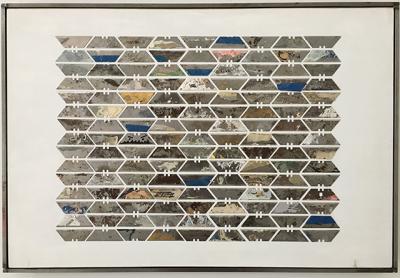Creative Catharsis at Crush Curatorial

How many times have you heard that an artist’s work was really good, because it was fetching five, six, or even seven and eight-figure prices? The art market has so pervaded the art world that even artists fall prey when discussing other artists.
In this climate, they cannot be blamed for building on success, or for considering how marketable a medium, style, or subject might be. Sometimes it might not be a dollar amount but an identity that is at stake in keeping with the norm. But what happens when the creative urge points them in another direction?
Addressing this dichotomy is a show called “Alt-Egos,” at Crush Curatorial, Karen Flatow’s potato barn studio and alternative exhibition space in Amagansett. She invited Scott Bluedorn, an artist and curator with a broad and deep digital Rolodex, to put together an exhibition that demonstrates a side of regional artists whose work we think we know, but who lead a double life creatively.
Mr. Bluedorn, known for his precisely drawn fine-art landscapes and fanciful subjects and his Greenport Harbor Brewery label designs, makes abstract wall-hung objects as well, constructed from found objects and resin. Patchy and colorful, they look not unlike very large missing puzzle pieces, and nothing like his drawings.
Joining Mr. Bluedorn and Ms. Flatow, who contributes her own drawings to the mix, are more than 40 artists. Most provide concurrent pieces to the work they typically create in their studios, but some are showing projects from much earlier years. A few of their sources are not too difficult to discern, but most are very surprising.
Standouts include Eric Fischl’s crude clownish caricatures of Trump administration insiders, created on his iPad. These satirical works are figurative, but not otherwise related to the painterly forms in his current canvases that also explore life in the Trump years (at Skarstedt Gallery in Manhattan through June 24). The collected drawings, presented as one work in a slide show format, are not for sale. Maybe the artist doesn’t want to give up his iPad, but it seems more likely a deeply personal project, pursued not out of creative intention, but cathartic release.
A Fulbright scholar, Kristina Felix incorporates fabric and sculpture in much of her recent work. In “Vise,” she adds ceramics to the mix, a medium that has caused her to reconsider her notions of craft and art as they relate to history and contemporary intellectual practice. In the piece, she stacks square wooden planks between layers of fabric and ceramic plates. The resulting tower is held together by tension only, making “Vise” even more vulnerable than it appears.
Charles Ly’s “Handle With Care” is a precise geometric composition of straight-edge blades mounted on wood. The artist’s typical use of pattern is organic in form: hair, leaves, feathers, and shells. Although the angled shape of the blades is consistent, each one is unique. Some appear presented as they were likely found, with rust or putty as decoration. Others are embellished with paint, ink, tape, and other materials. Rigidly organized, the composition is random in its overall placement of color, light, and shadow. It offers a new surprise at every viewing.
Jackie Black was included in last year’s “Artists Choose Artists” for her frank and confrontational photography, and it is startling to see her amplifier and ukulele in this show. Constructed from a metal can outfitted with strings and a shotgun shell box sporting a reclaimed speaker, both uke and amp are fully functional, if not tuneful. The instrument is both a descendant and disrupter of Picasso’s Cubist sheet-metal sculpture of a guitar — an intentional signifier, incapable of sound. According to the artist, she just wanted to have some fun.
Christine Sciulli risks being missed in an installation that plays with light in a subtle way, unrelated to her usual pieces. It’s a delightful surprise and a genius use of packing tape.
In a painting from 1952, Randall Rosenthal offers his 5-year-old view of the world marked by a fascination with fire. The work shows the early promise of a talent that eventually would be channeled into his trompe l’oeil creations of wood and paint.
With such a large roster, there is obviously much more to say, but space is limited. Other artists who stood out included Perry Burns, Idoline Duke, Charlotte Hallberg, Hiroyuki Hamada, Jon Kessler, Bill Komoski, Jane Martin, Hildy Maze, John Messinger, Mark Perry, Dalton Portella, Peter Spacek, Dan Welden, and Lucy Winton.
It’s impossible to rate a show this large on all of its parts, but the sum is impressive and the installation works despite the range of styles and formats. The show will close with a reception on May 26, with a possible performance by one or more of the participating artists.
